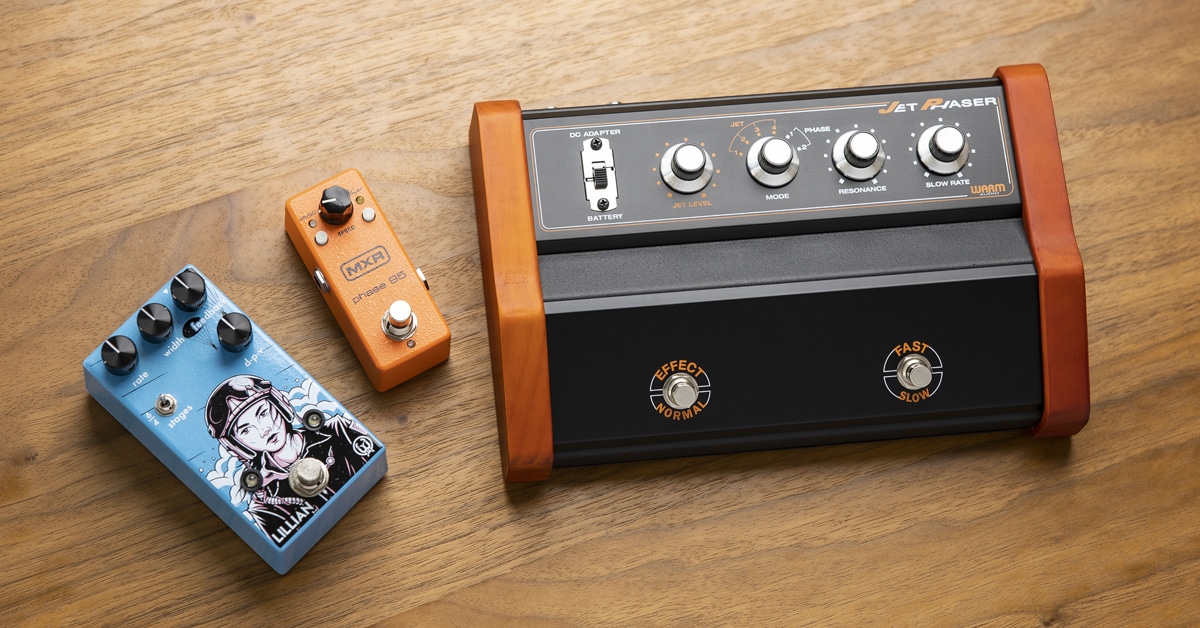When it comes to adding space, texture and movement to your sound, the phaser pedal is maybe the most versatile, and most underutilized, stompbox in history. There’s a reason players from Ernie Isley and St. Vincent to Billy Corgan and Chris Stapleton have incorporated that deliciously sweeping, harmonic-rich sound into their rigs, and today we’re going to break down some of the best phaser pedals you can get your hands (or feet) on.
Table of Contents
How Does a Phaser Pedal Work?
Comparing the Top Phaser Pedals
The Best Phaser Pedals of 2025
BOSS PH-3 Phase Shifter
EarthQuaker Devices Grand Orbiter Phase Machine
Electro-Harmonix Nano Small Stone Phase Shifter
Fender Waylon Jennings Phaser
MXR M290 Phase 95
Old Blood Noise Endeavors Dweller Phaser
Source Audio Lunar Phaser
Strymon Zelzah Multidimensional Phaser
Walrus Audio Lillian Phaser
Warm Audio Jet Phaser
In Closing
How Does a Phaser Pedal Work?
So, what is a phaser/phase shifter? At a high level, a phaser uses filters to create a series of peaks and valleys that sweep throughout the frequency spectrum of your signal. To do this, the effect creates a copy of your input signal (say, the output of guitar or electric piano) and passes it through a series of all-pass (full-bandwidth) filters, from as few as four to as many as 32, which alter the phase of different sections of the frequency spectrum. These filters are implemented in pairs, and each pair of filters is referred to as a filter stage. Each filter stage creates one movable frequency notch, so the more stages, the richer and more complex the final sound can be. An LFO (low-frequency oscillator) then modulates the center frequencies of these all-pass filters, moving them up and down. When this is mixed back in with the original unprocessed signal, it results in a moving, swooshing sound that can shift from a long, slow roll back and forth to a psychedelic high-speed wobble, depending on how you adjust its rate and depth, and how many filter stages you have available.
In addition, phasers with a Rate knob allow you to control the speed the LFO runs at, while controls labeled as Depth, Width or Sweep typically adjust the frequency range that the filters operate across.
So, whether you’re looking for a reissue of a bona fide classic, a boutique build, or just a solid, inexpensive phaser pedal, we have something here for you to inject some tone-thickening muscle to your sound.
Comparing the Top Phaser Pedals
|
Pedal Name |
Tonal Characteristics |
Power Draw |
Total Voicings |
|
Flexible, multi-stage digital precision |
9V DC, 50mA |
3 |
|
|
Dynamic rate modulation, from steady and mild to wild and swirly |
9V DC, 15mA |
2 |
|
|
Wah-like, rich, deep phasing, teetering toward psychedelic |
9V DC, 10mA |
2 |
|
|
Warm, classic vibe to far-out twang |
9V DC, 100mA |
2 |
|
|
4-stage effect with classic and modern swirl |
9V DC, 8mA |
4 |
|
|
4- or 8-stage phase repeater with unique time-stretching effects |
9V DC, 110mA |
2 |
|
|
Digital precision, morphable waveforms |
9V DC, 280mA |
3 |
|
|
Endlessly versatile, multi-dimensional modulation |
9V DC, 300mA |
6 |
|
|
4- and 6-stage phasing with luxurious analog vibes |
9V DC, 100mA |
2 |
|
|
Vintage analog, rich tonal versatility |
18V DC, 9mA |
2 |
The Best Phaser Pedals of 2025
BOSS PH-3 Phase Shifter
BOSS entered the phaser market with their very first pedal releases in 1977, introducing the PH-1, a 4-stage phaser with Rate and Depth controls. It soon evolved into the PH-1R with an added Resonance control. This was followed by the PH-2 Super Phaser with added functionality.
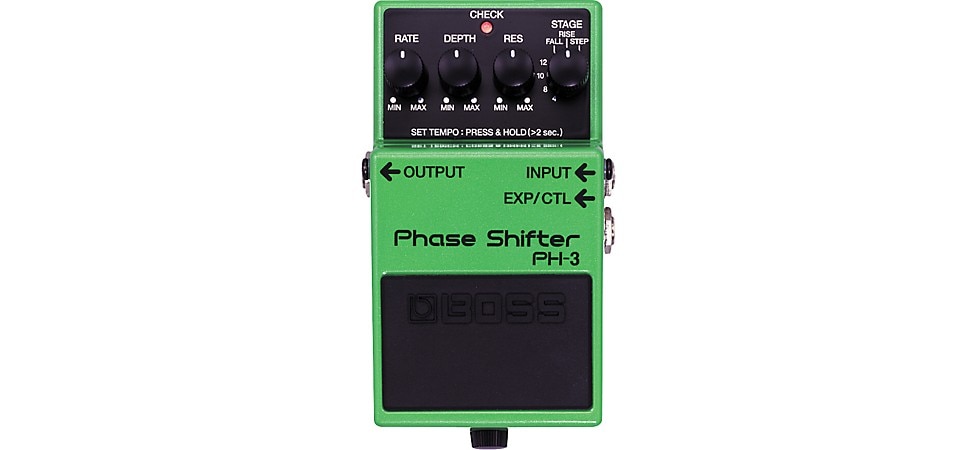
Pictured: BOSS PH-3 Phase Shifter
The PH-3 Phase Shifter, which debuted in 2000, is the digital descendant of the analog BOSS phasers, and there’s a good reason it’s been around for two decades. It’s the phaser equivalent of a Swiss Army knife, capable of providing nearly every phaser choice imaginable in one box. It has selectable 4-, 8-, 10- and 12-stage phasers, which alone would make it a coveted pedal.
But BOSS kept going, adding tap-tempo phase syncing and two essentially infinite phaser modes called Rise and Fall, which produce entirely upward- or downward-moving phaser sounds. Plus, if you have an expression pedal, you can control your Rate through it in real time.
EarthQuaker Devices Grand Orbiter Phase Machine
Why You Want to Buy It: This is a highly versatile, four-stage phaser that serves up anything from subtle pulses to rotary speaker simulations, complete with vibrato mode for added sonic dimensions.
Things to Consider:
- Features a dedicated rate control for the switchable vibrato mode
- Standard size with light power needs
- True bypass with silent Flexi-Switch, which allows for momentary and latch-style switching
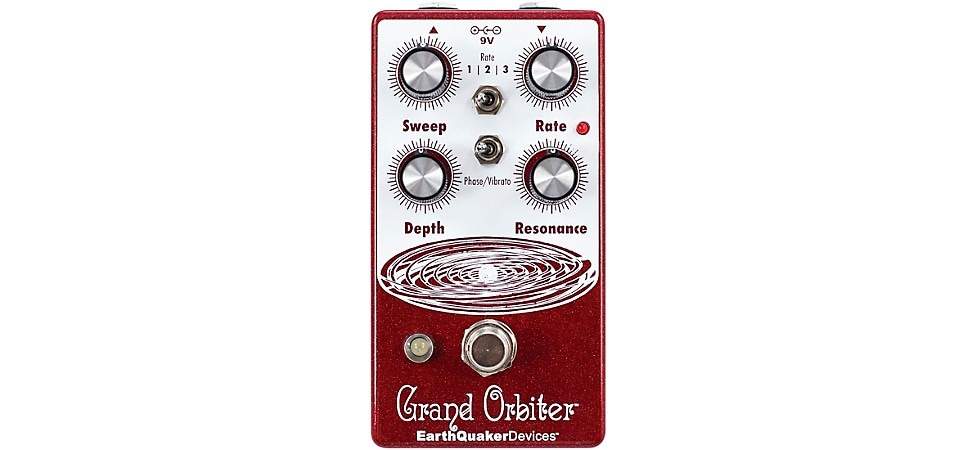
Pictured: EarthQuaker Devices Grand Orbiter Phase Phase Machine
One of the most advanced analog phasers out there, the EarthQuaker Devices Grand Orbiter packs an incredible range of sonic possibilities into one handsome red box. On the surface, it’s a 4-stage phaser using operational transconductance amplifiers (OTA) like the original Small Stone. The sound that produces by itself would make this a solid entry on our list.
But EarthQuaker didn’t stop there. They added a toggle switch with three modulation rates: Rate 1 is a slow sweep, and Rate 3 is fast—it’s Rate 2 that changes the game. This mode kills the LFO entirely, turning your swirly phaser into a fixed resonant filter, delivering an effect that calls to mind the intro to Pete Townshend’s “Let My Love Open the Door.”
If that wasn’t enough, like the Lillian, the Grand Orbiter is also switchable between phase and vibrato, effectively making it two pedals in one. Finally, it could be easy to overlook that slow sweeping Rate 1 setting, but if you let the effect run over time, it builds upon itself to become warmer, darker and thicker for a kind of velvety texture over your tone.
Electro-Harmonix Nano Small Stone Phase Shifter
Why You Want to Buy It: Famed for its rich, deep phasing, this pedal delivers a classic effect that can dramatically transform your tone with a single twist.
Things to Consider:
- Very low power draw
- Analog circuit for a warm, immersive effect
- True bypass preserves your guitar's natural tone when disengaged
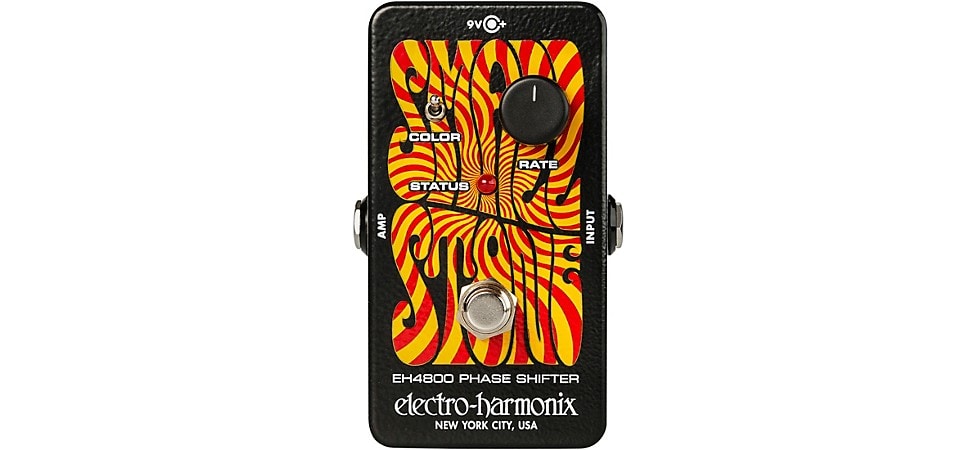
Pictured: Electro-Harmonix Nano Small Stone Phase Shifter
Remember when we said the Phase 90 was one of the most revered phaser pedals on the planet? Here’s another one. The Electro-Harmonix Small Stone premiered in 1974, not long after the Phase 90. The original was also a 4-stage phaser, and featured a popular Color switch that widened the sweep and punched up the feedback, making the effect more pronounced and intense, sounding a lot like a wah pedal rocking back and forth from wide open to closed.
Don’t let the wah reference fool you into thinking this is a genre-specific pedal, though. The Small Stone has long been a favorite of artists like Radiohead and Tame Impala for its ability to paint a lush texture over any instrument and to provide movement that can effortlessly shift from drowsy to psychedelic.
The Nano Small Stone delivers all the swooping goodness of the original, but in a tiny footprint. You can use it to capture the mellow rotary feel of Chris Stapleton’s “Hard Livin” or its inspiration, Waylon Jennings’ “Are You Sure Hank Done It This Way.” Or, ramp it up to the luscious sweep of Tame Impala’s “Solitude Is Bliss” with a simple twist of the rate knob and flip of the color switch.
Fender Waylon Jennings Phaser
Why You Want to Buy It: With a ’70s vibe and heavy-duty build, its all-analog design channels Waylon’s far-out, funkified country vibe, but its versatile sweeping ability makes it an enticing tool for any playstyle.
Things to Consider:
- Intuitive Range, Rate and Feedback controls featuring Fender top hat-style knobs
- All-analog design requires more power than most
- Compact footprint and top-mounted jacks allow for flexible pedal arrangement
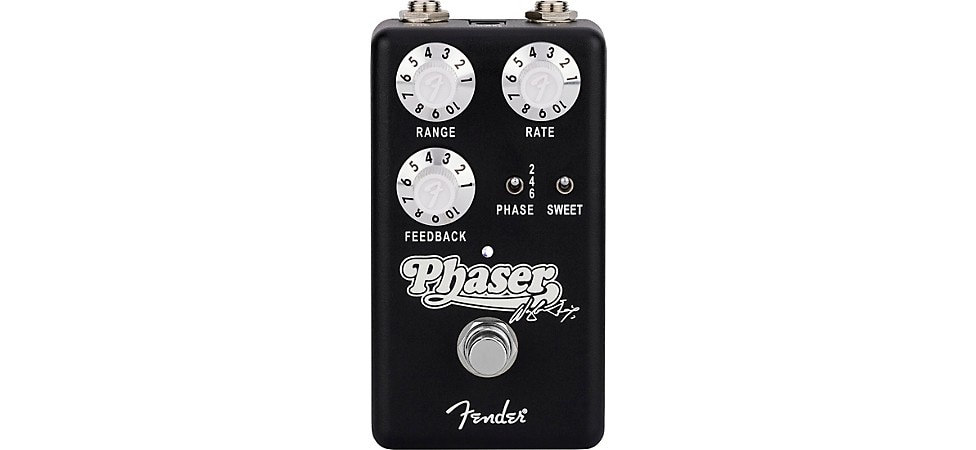
Pictured: Fender Waylon Jennings Phaser
Fender's tribute to Waylon Jennings is not just about replicating the signature sound of a country music titan; it's about capturing the essence of an era in a pedal that's versatile enough for today's guitarist. The Waylon Jennings Phaser pedal delivers a rich, analog warmth that can only come from a pedal designed with such specific and eclectic inspiration. Its four distinct voicings offer a range from subtle phase shifts to a pronounced, swirling effect, enabling you to find your perfect sound for any setting or genre. Whether you’re playing honky tonk or experimenting with mind-bending genre blending, this pedal adds a layer of personal authenticity and depth to your music.
The Fender Waylon Jennings Phaser is more than a nod to the past—it's a bridge to the future of guitar sound. Its intuitive design encourages experimentation, while the build quality ensures it can stand up to the rigors of touring and studio sessions. This phaser is for any guitarist looking to add a piece of musical history to their sound arsenal, with the reliability and sonic quality Fender is known for.
MXR M290 Phase 95
Why You Want to Buy It: This compact pedal combines the iconic Phase 45 and Phase 90 circuits, offering a versatile range from subtle, vintage swirls to pronounced, modern phasing effects.
Things to Consider:
- Ultracompact size fits any pedalboard
- One-knob Speed control
- Switchable 45/90 modes and a Script switch for multiple sonic styles
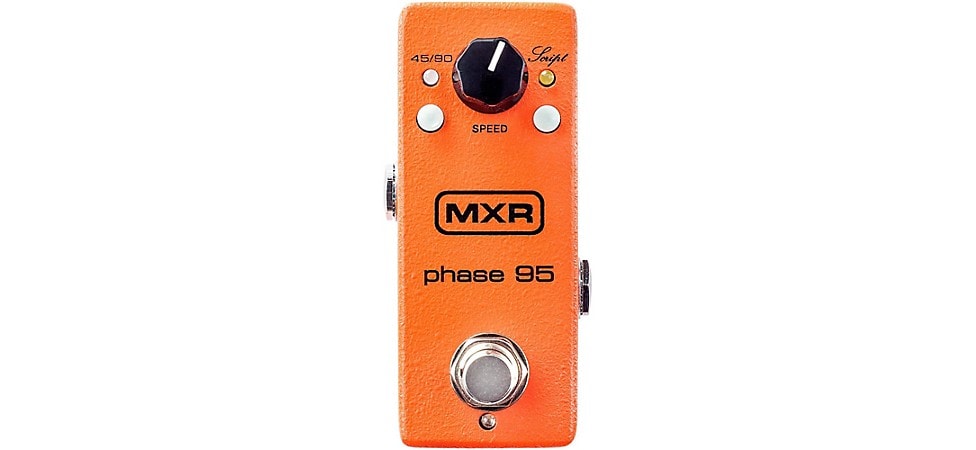
Pictured: MXR M290 Phase 95
In 1974, MXR released its very first product, the Phase 90. This pedal helped put both MXR and phaser pedals on the map with its beautifully streamlined and minimalist box. It’s a 4-stage phaser, meaning that the treated signal runs through four pairs of all-pass filters, creating four notches or phase cancellation moments.
The Phase 90 was the favored box of Eddie Van Halen, and it has gone on to be one of the most revered phaser pedals on the planet. A quick listen to “Eruption” or “Atomic Punk” will give you a great primer in MXR’s phaser style, notable for incredible width and texture.
In 1974 MXR released the Phase 45, the much-loved mellow little sibling to the bold 90. Part of the Phase 90 and 45’s beauty was their simple operation. They had only one knob for speed to control the rate of your oscillation. In the quest for more flexibility, in 1975 MXR released the Phase 100, which featured four different phase intensities with wider sweep and notch depth. Keith Richards used a Phase 100 on “Shattered,” and Mick Jones of the Clash favored both 90s and 100s.
With the compact and versatile Phase 95, MXR takes the phaser game to a new level. Not only can you toggle between Phase 45 and Phase 90 circuits, getting the best of both worlds, but MXR’s awesome Script switch lets you remove feedback for more headroom and clarity as well, allowing you to toggle between vintage- and modern-style phasing. Perfect for the phaser pedal newcomer and veteran alike, this puppy takes up very little space and produces massive, versatile results.
Old Blood Noise Endeavors Dweller Phaser
Why You Want to Buy It: This pedal reimagines phasing as a form of time manipulation, stretching and compressing the space between moments for a truly unique modulation effect.
Things to Consider:
- Stretch feature warps your sound in never-before-heard ways
- Expression pedal input for even more control over the Stretch parameter
- Toggle between (wave) Shape and Voice (staging types) switches for quick changes
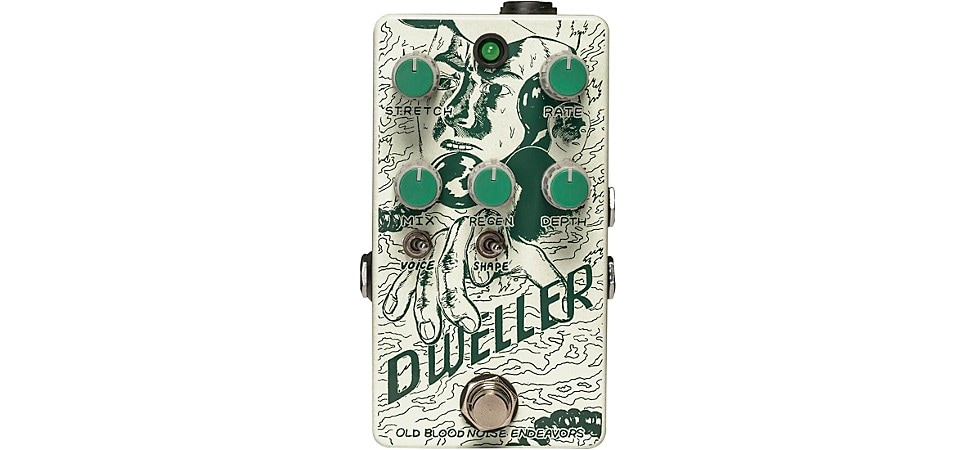
Pictured: Old Blood Noise Endeavors Dweller Phaser
We’re rounding out our list of the best phaser pedals with the mind-boggling Old Blood Noise Endeavors Dweller. This isn’t just a phaser pedal, it’s a phase repeater. That’s a phaser with built-in delay, but it’s also way more than that.
Begin with the Voice switch that lets you choose between 4- and 8-stage phasing, and then move to the Shape switch that toggles between sine, triangle and random step waves. Next, adjust the Depth knob between dry and wet phaser signals—the higher you go, the wobblier it gets. The Regen knob intensifies the resonance and phasing notches for a deeply pronounced and seasick swaying. Combine maxed Regen with Random shape and you get something like the Death Star trying to operate under water.
Now that you have your perfect phaser sound dialed in, have a go at that Stretch knob that controls the delay time within your phaser setting. The resulting sounds are impossible to adequately describe. Let’s just say it sounds like what you’d hear if you recorded Radiohead, Bjork, St. Vincent and Brian Eno’s lucid dreams and played them all back at the same time.
Source Audio Lunar Phaser
Why You Want to Buy It: It brings together three types of lush, analog-sounding phaser effects in one compact, programmable unit, offering unprecedented tonal control and flexibility.
Things to Consider:
- Stereo I/O, expression and tap functionality
- Switchable analog buffered or relay-based true bypass
- MIDI compatible for integration into more complex setups
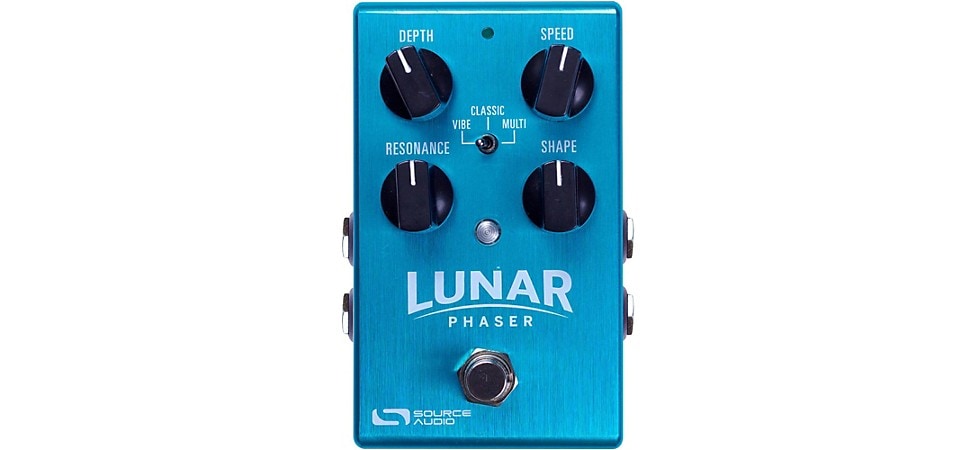
Pictured: Source Audio Lunar Phaser
To talk about the future of phaser pedals, we have to look deep into the past. In 1968, an engineer named Fumio Mieda designed a pedal for Shin-Ei called the Uni-Vibe. He was trying to design an effects pedal for organs that would simulate a rotary cabinet. Although it was considered a chorus/vibrato pedal, it was essentially the first phaser pedal—the one that Jimi Hendrix, Jimmy Page and David Gilmour used to great effect.
Why are we mentioning this pioneering pedal now? Because the Lunar Phaser by Source Audio features an accurate Vibe mode based on the Uni-Vibe. The best part is, that’s not even the most impressive feature on this little digital wonder. It also features a Classic mode that emulates a 4-stage analog phaser, and Multi-mode with two 4-stage phasers running at once … and it’s all true stereo for an even wider, more expansive swirling effect.
With the Neuro mobile app, you can upload chorus and flanger effects to the pedal, and access MIDI control and deep, detailed effect editing right on your phone or tablet.
Strymon Zelzah Multidimensional Phaser
Why You Want to Buy It: True to Strymon’s forward-thinking reputation, this powerful stompbox lets you explore new dimensions of sound with matchless modulation flexibility.
Things to Consider:
- Higher power requirement than most, due to its advanced specs
- Slightly larger than the run-of-the-mill pedal, with its comprehensive controls
- Dual-engine architecture and six voicing options offer a myriad of options
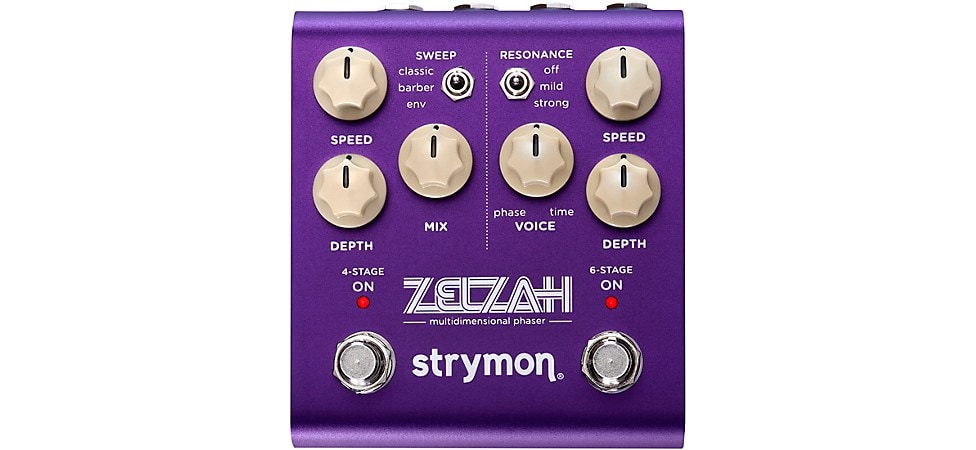
Pictured: Strymon Zelzah Multidimensional Phaser
The Zelzah multidimensional phaser modulation pedal is a testament to Strymon's commitment to pushing the boundaries of what an effects pedal can be. With its dual-engine design, the Strymon Zelzah phaser pedal offers an extraordinary range of sounds, from classic phasing to innovative, otherworldly effects. Its 4-stage and 6-stage phasers can be used independently or combined, offering unprecedented versatility. Zelzah beckons guitarists to dive deep into the possibilities of modulation, crafting sounds that can range from the subtly nuanced to the wildly experimental.
Beyond its sound-shaping prowess, the Zelzah stands out for its user-friendly interface, allowing for intricate sound shaping with an intuitive 6-knob interface, controlling speed, depth, voice (phase/time) and wet/dry mix. This formidable phaser pedal also supports expression control over multiple parameters, as well as MIDI control over most switches and knobs, allowing for a fully customizable workflow. Zelzah’s robust construction and thoughtful design mean it's built to last, making it a worthy addition to any pedalboard. Whether you’re a seasoned pro or new to the world of modulation effects, the Strymon Zelzah pedal makes it easy to dial in your ideal phase.
Walrus Audio Lillian Phaser
Why You Want to Buy It: It thrives on its analog phasing capability, providing a sweep of tonal possibilities from subtle, nuanced movement to rich, enveloping waves, making it an ideal choice for both rhythmic texture and lead embellishment.
Things to Consider:
- Features multi-stage phasing that can be deeply fine-tuned
- Top-facing I/O and power jacks for flexible pedalboard arrangement
- True bypass ensures your tone is untouched when the pedal is not being used
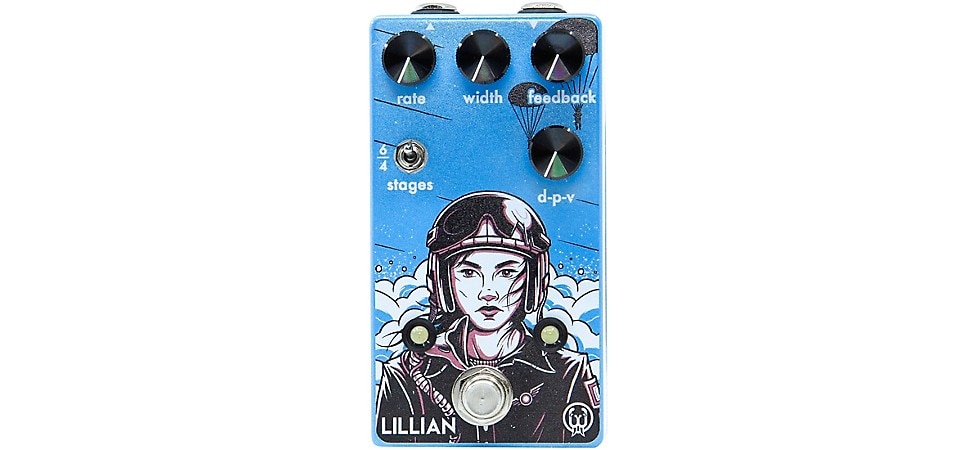
Pictured: Walrus Audio Lillian Phaser
Walrus Audio treats us to a decidedly modern take on the phaser effect with the Lillian. Select between tight 4-stage and expansive 6-stage phasing with the flip of a switch—both settings provide luxurious, warm analog wooziness. Hold down the footswitch and you get the effect momentarily for those big chorus intros and solos.
Walrus Audio engineers also took a cue from their popular Julia chorus/vibrato pedal and fitted the Lillian with a D-P-V knob that allows you to dial in a mix of dry, phaser and vibrato signals. Set the dial to noon and you get an even mix of dry and phased signals. Crank it to 10 and you get a warbly, pitch-shifted vibrato that sounds like an unpredictable reel-to-reel player, or the moment in Fear & Loathing in Las Vegas when the drugs kick in. In short, it’s trippy.
Warm Audio Jet Phaser
Why You Want to Buy It: Inspired by the legendary jet phaser tones, this pedal offers both lush-to-Leslie-inspired phasing and jet-like overdrive effects, making it incredibly versatile for creative musicians.
Things to Consider:
- Combines phaser and fuzz effects, with multiple stages and modes for one-of-a-kind sounds
- Large footprint and 18V, 9mA power draw
- True bypass for maintaining signal integrity when not in use
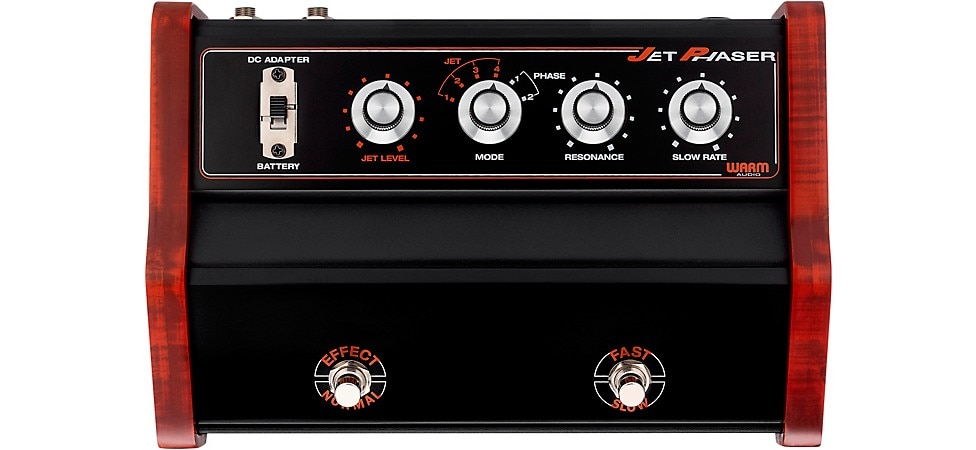
Pictured: Warm Audio Jet Phaser
In 1975, Roland released the Jet Phaser, a bold step forward in phaser technology. Thanks to its distorted and powerful Jet setting, this pedal pumped out a huge and amazing sound worthy of its name. This is the pedal heard on Graham Central Station, Isley Brothers and Sly and the Family Stone hits. Its popularity was due not only to the massive Jet settings, but also to its subtle musicality thanks to how gradually the phaser speed changed when you hit the fast/slow switch—it can take you into Leslie rotary speaker territory in seconds.
The Warm Audio Jet Phaser captures that power and subtlety, with four Jet settings to select combinations of bright or dark fuzz with shallow or deep phasing. Choose a setting and play with the Resonance control for sci-fi sounds worthy of Blade Runner. Warm Audio also points out that continuously switching between the fast and slow modes, like an organ player, lets you hit a delicious in-between sweet spot. As Larry Graham proved in the 1970s, the Jet Phaser sounds amazing on bass, too. In fact, you could put this on pretty much anything and achieve some gorgeous effects that alternate swiftly from sweet to aggressive.
In Closing
The range of applications for the phaser is as big as your imagination. As the pedals in this article show, it’s a critical element for a richly textured tone, no matter if it’s for a rhythm guitar pad, a spacey solo or the drums on Zeppelin’s “Kashmir.” From the simplest one-knob analog box to digital wonders that blur the lines between effects, there’s something out there to fit exactly what you hear in your head.
It’s hard to know how much you want to invest in a phaser pedal until you’ve heard what they can do in real life. Head down to a Guitar Center and give a few a test drive. Also, we sometimes get in true vintage originals if an OG Phase 90, Small Stone or even Jet Phaser is calling your name.










